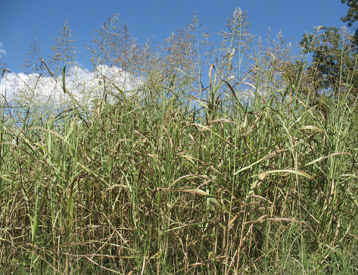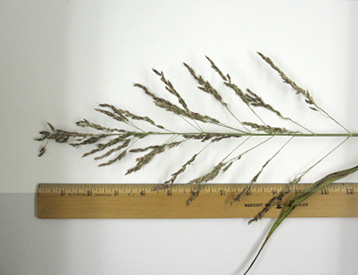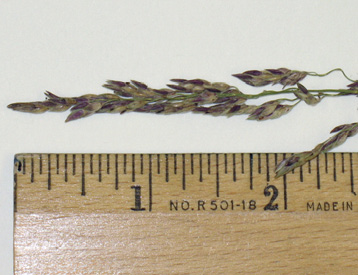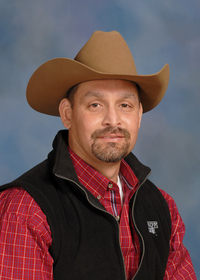Johnsongrass
Johnsongrass [Sorghum halapense (L.) Pers.] is a perennial warm-season grass native to the Mediterranean. It was introduced as forage in the early 1800s. Johnsongrass is found in cultivated fields, rights-of-way, Conservation Reserve Program lands, abandoned fields, juvenile timber stands, and hayfields. Johnsongrass can cause cyanide poisoning in livestock, particularly following stress such as cutting, frost, or chemical application that causes wilting. Cyanide poisoning can also cause deformities in livestock offspring. Because of the threat to livestock, the Texas Legislature in 1895 made planting johnsongrass on rented land illegal. Six years later, they created a law to fine railroad companies for failing to control johnsongrass on rights-of-way. Johnsongrass is a noxious weed in many states and can be problematic in all midsouth states on roadsides, in cultivated fields, and in hayfields.



Description
Vegetative Growth
Johnsongrass is a perennial grass that produces rhizomes and forms dense stands of stems up to 6 feet tall. Nodes along stems are hairy, but internodes are smooth. Leaf blades are up to 25 inches long and just over an inch wide. They are covered with dense, long hairs on the upper surface. Sheath margins are hairless or may have hairs along the margin and edge. Ligules are membranous, with hair along the margin and edge, about 0.1 inches long.
Flowering
Flowering occurs from May to October. The inflorescence is a panicle about 25 inches long and about 8 inches wide. The main and ascending branches are rough-textured with pubescent joints along the main stem. The grain is small, roughly 0.8 inches long, generally reddish, and oblong to ellipsoid.
Dispersal
Johnsongrass can be spread by rhizomes in soil, by seed on equipment, or in contaminated seed or hay. Mowing, movement of contaminated soil, or other activities on roadsides or fields also spread johnsongrass. Specifically, johnsongrass disseminates by seed and rhizomes.
Habitat
Johnsongrass is a problem in pastures, fields, prairies, roadsides, and waste places. It can form dense stands, replacing the surrounding native vegetation. Although it can be used as a forage crop, caution should be taken because of potential cyanide poisoning. On roadsides, its height can obstruct visibility. It is tolerant of a wide range of terrestrial conditions, but it generally does not tolerate deep shade.
Distribution
Johnsongrass is widespread in the United States, possibly in all states except Maine and Minnesota. It has escaped in other parts of the world, as well. It is easily spread both by rhizomes in soil and by seed in contaminated hay and equipment. It is widespread in all midsouth states, particularly in open areas along roadsides and in pastures.
Control Methods
Biological
There are no known biological methods. Continual grazing by foraging animals at high stocking rates will reduce populations. Hogs consume johnsongrass rhizomes.
Chemical
Many herbicides are effective for johnsongrass control in various application sites (Table 1). Most require either crop oil or a nonionic surfactant for satisfactory results. Herbicides should be applied when johnsongrass is actively growing and not affected by adverse environmental conditions. For best results, refer to herbicide labels for specific application sites, rates, methods, and timing. Herbicides that only control seedling johnsongrass are not listed. Some populations of johnsongrass in Mississippi are resistant to glyphosate. See MSU Extension Publication 1532 Mississippi Weed Control Guidelines for additional information.
Mechanical
No mechanical controls for johnsongrass are currently in widespread use. Mowing can be done in some infestations, but this does not generally eradicate johnsongrass. Since johnsongrass has long rhizomes, hand-removal is difficult. However, hand-removal for small patches in a landscape or vegetable garden may be feasible. Flooding infested areas with 2 to 4 inches of water for 3 to 6 weeks in early spring will kill most rhizomes, but it does not impact viable seed in the soil profile.
Cultural
Cultural controls are generally not effective for johnsongrass. This weed invades a wide variety of both disturbed and undisturbed sites and have varied moisture levels, pH ranges, and soil textures. Johnsongrass generally does not do well in dense shade.
References
Ball, C. R. (1902). Johnsongrass: Report of investigations made during the season of 1901. USDA Bulletin 11.
Knight, A. P., & Walter, R. G. (2001). A guide to plant poisoning of animals in North America. Teton New Media.
McWhorter, C. G. (1989). History, biology, and control of johnsongrass. Review of Weed Science, 4: 85–121.
USDA, NRCS. (2007, Aug. 06). The PLANTS Database. http://plants.usda.gov
Vasey, G. (1889). The agricultural grasses and forage plants of the United States; and such foreign kinds as have been introduced. USDA Botanical Division Special Bulletin.
|
Chemical |
Trade name |
|
Asulam |
Asulam, Asulox, Divulge, etc. |
|
Bromacil |
Hyvar, Fenocil, Weed Easy, etc. |
|
Clethodim |
Cleanse, Dakota, Envoy, Section, Select, Shadow, Tide, Volunteer, etc. |
|
Fluazifop |
Fusilade, Fusilade II, Ornamec, etc. |
|
Fluazifop + Fenoxaprop |
Fusion |
|
Glufosinate |
Cheetah, Finale, Glufosinate, Ignite, Interline, Lifeline, Refer, Rely, etc. |
|
Glyphosate |
Accord, Cornerstone, Eraser, Glyfos, GlyPro, Helosate, Razor, Roundup, Roundup Pro, etc. |
|
Glyphosate + 2,4-D |
Enlist Duo |
|
Glyphosate + Metolachlor |
Sequence |
|
Glyphosate + Metholachlor + Mesotrione |
Halex |
|
Glyphosate + lmazethapyr |
Extreme, Mad Maxx, Thunder Master, etc. |
|
lmazamox |
Beyond, Clearcast, Raptor, Vulture, etc. |
|
lmazapic |
Cadre, lmazapic, Panoramic, Plateau, etc. |
|
lmazapic + Glyphosate |
Journey |
|
lmazapyr |
Arsenal, Chopper, Ecomazapyr, Habitat, lmazapyr, Polaris, Stalker, Rotary, etc. |
|
lmazapyr + Diuron |
lmazuron, Mojave, Sahara, Topsite, etc. |
|
lmazapyr + Glyphosate |
Eraser Max, OneStep, Remnant, etc. |
|
lmazapyr + Metsulfuron |
Lineage Clearstand |
|
lmazapyr + Sulfometuron + Metsulfuron |
Lineage Prep |
|
MSMA |
MSMA 6, MSMA 6.6, Target 6, Target 6.6, etc. |
|
Nicosulfuron |
Accent, Primera, Zest, etc. |
|
Nicosulfuron + Metsulfuron |
Pastora |
|
Nicosulfuron + Rimsulfuron |
Steadfast Q |
|
Primisulfuron |
Beacon |
|
Primisulfuron + Dicamba |
Northstar |
|
Primisulfuron + Prosulfuron |
Spirit |
|
Prometon |
Pramitol, Scortched Earth |
|
Quizalofop |
Assure II, Provisia, Se-Cure, Targa, etc. |
|
Sethoxydim |
Sethoxydim, Poast, Poast 11, Segment, etc. |
|
Sulfometuron |
SFM, Spyder, Oust |
|
Sulfometuron + Metsulfuron |
SFM Extra, Spyder Extra, Oust Extra |
|
Sulfosulfuron |
Certainty, Outrider, Maverick |
The information given here is for educational purposes only. References to commercial products, trade names, or suppliers are made with the understanding that no endorsement is implied and that no discrimination against other products or suppliers is intended.
Publication 3205 (POD-04-24)
By John Byrd Jr., PhD, Extension/ Research Professor, Plant and Soil Sciences; Victor Maddox, PhD, Senior Research Associate, Plant and Soil Sciences; and Randy Westbrook, PhD, former Invasive Species Specialist, U.S. Geological Survey.
The Mississippi State University Extension Service is working to ensure all web content is accessible to all users. If you need assistance accessing any of our content, please email the webteam or call 662-325-2262.





